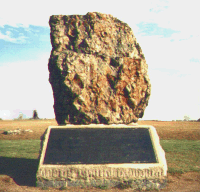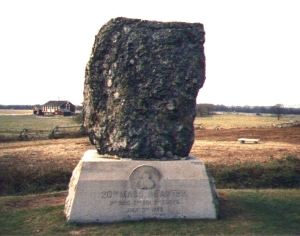 The 20th Massachusetts Infantry played a key role during one of
the Civil War's critical moments: the height of Pickett's Charge at
Gettysburg on July 3, 1863. The 20th Massachusetts moved in to reinforce
the Union position at a critical moment, to prevent a Rebel breakthrough
that may have changed the course of history. If you visit this area of the
Gettysburg battlefield, you will see many statues and magnificent
monuments. To the left of the famous "copse of trees", the high-water mark
of the Confederacy, is the quite unusual 20th Massachusetts Memorial. It
is a rough edged 30-ton rectangular monolith of "Roxbury puddingstone".
This pebbled conglomorate type of rock is native to Massachusetts. On the
base of the monument is a bronze plaque with the following text: The 20th Massachusetts Infantry played a key role during one of
the Civil War's critical moments: the height of Pickett's Charge at
Gettysburg on July 3, 1863. The 20th Massachusetts moved in to reinforce
the Union position at a critical moment, to prevent a Rebel breakthrough
that may have changed the course of history. If you visit this area of the
Gettysburg battlefield, you will see many statues and magnificent
monuments. To the left of the famous "copse of trees", the high-water mark
of the Confederacy, is the quite unusual 20th Massachusetts Memorial. It
is a rough edged 30-ton rectangular monolith of "Roxbury puddingstone".
This pebbled conglomorate type of rock is native to Massachusetts. On the
base of the monument is a bronze plaque with the following text:
"This monument marks the position occupied by the 20th Massachusetts
Infantry in line of battle on July 2, 1863, until (on July 3) it
advanced to the front of the copse of trees at right to assist in
repelling the charge of Longstreet's corps. This tablet is placed by
their comrades in honor of Colonel Paul Joseph Revere, First Lieutenant
Henry Ropes, Second Lieutenant Sumner Paine and 41 enlisted men who were
killed or mortally wounded." Massachusetts
Infantry in line of battle on July 2, 1863, until (on July 3) it
advanced to the front of the copse of trees at right to assist in
repelling the charge of Longstreet's corps. This tablet is placed by
their comrades in honor of Colonel Paul Joseph Revere, First Lieutenant
Henry Ropes, Second Lieutenant Sumner Paine and 41 enlisted men who were
killed or mortally wounded."
The puddingstone boulder was sent by rail from Roxbury (a section of
Boston) to Gettysburg in 1886 by the Regimental Association. The bronze
tablet was placed upon it and given by Mrs. Nathaniel Thayer of Boston, a
daughter of Colonel Paul Revere, the third colonel of the Regiment and
grandson of the Revolutionary War hero.
The idea for this unusual monument came from some of the 20th Mass.
soldiers raised in Roxbury, who as children climbed on such large
puddingstone boulders. Fittingly, the Massachusetts General Laws state
that puddingstone is "the rock or rock emblem of the commonwealth." This
law was enacted in 1983.
Puddingstone is composed of different materials deposited from afar by
erosion and glaciation, washed by the ocean and cemented into a sort of
natural concrete by heat, pressure and time. It is found in deposits
between the Blue Hills and the Atlantic Ocean , in Dorchester, Mattapan
and Milton, Mass., as well as in Roxbury. It was used as a building
material in the 19th Century. Among the Boston churches built of
puddingstone are the Cathedral of the Holy Cross in the South End, and the
Old South Church at Dartmouth and Boylston St. across from the Boston
Public Library.
Link
to the other unique monument: "The Lion at the Library"
|